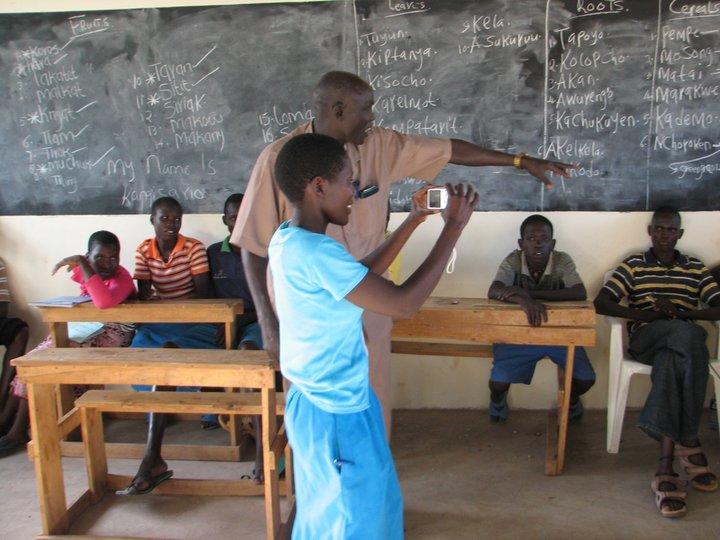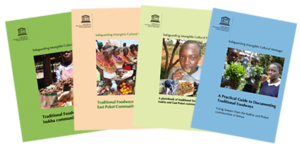Documenting traditional foodways of Kenya

School children and community leaders help document and produce four photo-filled publications on traditional foodways in two Kenyan communities.
“We wanted to share what we learned with the community, so we organized a photo-showing event. What we realized was that the screening not only helped local people understand the study, but in that relaxed atmosphere, they shared even more valuable information with us. People would comment and tell us things we didn’t find out during the household surveys or focus group interviews. So we thought, ‘Why not get people to document and share their food and culture themselves?'” – Yasu Morimoto, Bioversity International scientist.
This was the driving force behind an initiative to document traditional foodways in two contrasting communities in Kenya – Isukha and East Pokot (one agricultural, one pastoral). Foodways are where food, culture and tradition intersect.
“When it comes to food, there is always an interconnection with many aspects of people’s lives," says Patrick Maundu, an ethnobotanist who is part of the initiative. "Food is tied to planting activities, ceremonies and other events throughout the year. You cannot just look at food in isolation, as how it is stored, prepared, cooked or eaten is all part of the bigger picture.”
The partners of the initiative aims not only to better understand and preserve the unique food cultures of these communities, but also to recognize their valuable skills, practices and the agricultural biodiversity that the communities use and conserve in their landscapes.
The result: four publications filled with photos and information collected by schoolchildren who were given and trained to use digital cameras; edited and put together with the help of school teachers, community leaders and researchers involved in the project:

(links at end of article)
The first two books describe the way food is grown, collected, prepared and eaten in the Isukha and East Pokot communities, including the cultural aspects associated with them. The third, presents a collection of photographs taken by primary school children from the two communities. Finally, the Practical Guide provides useful information for those who might want to replicate this methodology elsewhere, be it for foodways or other indigenous knowledge and practices.
For Bioversity International, it is particularly important to understand how and why people might conserve biodiversity or use lesser-known species.
“By studying foodways, we may discover unexpected reasons for which people appreciate diversity, reasons that would otherwise be difficult to find out,” explains Morimoto.
“For example, in East Pokot, pastoralists like to keep different types of cows, because young men of the tribe are each nicknamed after a cow’s colour, pattern, horns or other feature. During their initiation ceremony, these nicknames are integrated into their songs. So the more names and colours are used, the more beautiful the ceremonial song will be.”
Culture often plays a role in providing a niche market for disappearing species and varieties that can have other important traits.
“There might be other benefits from this diversity, such as climate change adaptation or disease resistance. But for that community, they are conserving that diversity because they want their songs to be more colorful and beautiful,” adds Morimoto.
An unexpected outcome of the initiative was that the communities were motivated to further share their foodways with others. Local leaders organized cultural exchange events between the two communities and also held festivals within the communities themselves to demonstrate their foodways through cooking, singing and dancing.
School children were an integral part of the food fairs, displaying their local foods and the photos they took for the initiative. “Before we didn’t have much information about these communities. Getting them involved in the documentation was like a starting point, an igniting activity for recognizing their food practices and to promote the conservation of biodiversity. As scientists, it is our responsibility to provide evidence of this cultural function so that we can identify new community development approaches that are economically and culturally acceptable and sustainable for local farmers,” says Morimoto.
The methodology is relatively cheap and easily replicable in other parts of the world. The Ministry of Gender, Sports, Culture and Social Services, are already looking into using it in more schools in Kenya.
Links to the four books:
 Foodways Stories: Isukha (agricultural) community
Foodways Stories: Isukha (agricultural) community Foodways Stories: East Pokot (pastoral) community
Foodways Stories: East Pokot (pastoral) community Foodways Stories: A photo book (Isukha and East Pokot)
Foodways Stories: A photo book (Isukha and East Pokot) Practical Guide for Foodways Stories
Practical Guide for Foodways Stories
‘Safeguarding traditional foodways of two communities in Kenya’ was launched by UNESCO Nairobi with financial assistance from the Government of Japan. It is part of a global project for the Safeguarding of the Intangible Cultural Heritage. Bioversity International was part of the management team, which also included the Ministry of Gender, Sports, Culture and Social Services, and the National Museums of Kenya.
